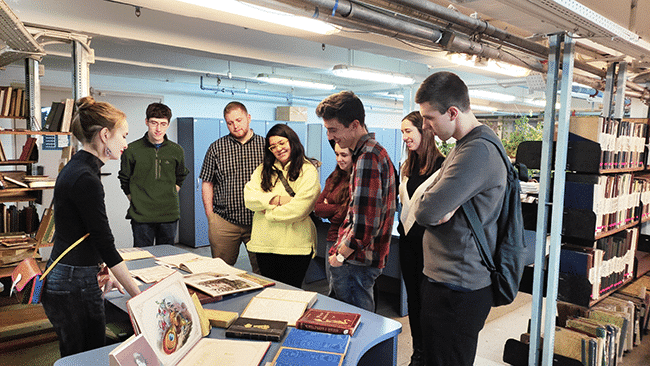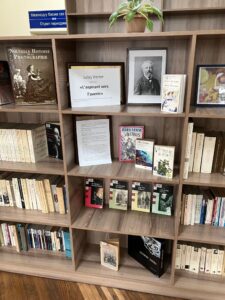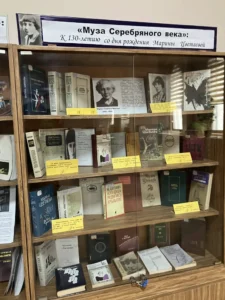Russian literature uses the same forms and structures as well as literary and poetic devices as other great Western literature. One can find in Russian literature fiction and nonfiction, novels, short stories, and poems, all containing narrative structure, metaphor, simile, metonymy, and other common devices. Thus, Russian literature can be analyzed with many of the same concepts and tools with which students of literature are bound to be well familiar.
The following free bilingual Russian vocabulary lesson is meant for advanced students of Russian who are also deeply interested in analyzing and discussing Russian literature. This lesson seeks to build your vocabulary by providing Russian phrases within English text.
Note that Russian phrases already used previously in the text will often not have the translation provided. Challenge yourself to learn as you go!
Structure and Classification
Whether you’re studying in Russia or the US, if you’re learning Russian language, you’re probably also reading classic Russian literature. Here is some useful vocabulary for discussing literature.
Литература (literature) can be художественная литература, or документальная, небеллетристическая литература (non-fiction). Both of these types of literature can contain a предисловие (preface), пролог (prologue), and эпилог (epilogue).
There are many different subtypes of художественная литература (fiction): фэнтези (fantasy), мистика/ужасы (horror/ghost stories), научная фантастика (science fiction), криминальная литература/детектив (crime/detective), любовные истории (romance), юмористический рассказ (humor), and историческая проза (historical fiction).
There are also lots of different types of literary works: роман (novel), повесть (story, tale, narrative), рассказ (short story), стихотворение (poem), and антология (anthology), a collection of literary works chosen by the compiler. A format that is not as common in modern fiction is a роман в стихах (novel in verse), such as Pushkin’s Евгений Онегин (Eugene Onegin). Every literary work has герои (characters), including a главный герой (main character) and an отрицательный герой (villain).
A typical структура сюжета (plot structure) includes several parts. First, the экспозиция (exposition) представит героев, (introduces the characters) and место и время действия (place and time of action): кто, где, когда (who, where, when). The переворотный момент (inciting incident) presents the первое столкновение конфликтующих сторон (first conflict between the parties). Then, the развитие действия (rising action), кульминация (climax), спад (falling action), and развязка (denouement), which ties up any loose ends to the story, all develop the story to its финал (conclusion).
In many литературные произведения (literary works), символы (symbols) are important, and each символ выражает (symbol represents) an idea.
Предзнаменование (foreshadowing) is a литературный приём (literary device) in which the author drops subtle hints about events or developments that will occur later in the story. A common example is a символ беды (symbol of trouble), such as черная кошка, перебежавшая дорогу (black cat crossing someone’s path), карканье ворона (a crow’s cry), гроза (a thunderstorm), or внезапно потухшая свеча (a candle that suddenly goes out).
Literary Devices
Knowing литературные приёмы (literary devices) that авторы (authors) use can help readers анализировать литературу (analyze literature). One of the most common литературные приёмы (literary devices) is a метафора (metaphor), a фигура речи (figure of speech) that describes an object by stating that it is in some way the same as another otherwise unrelated object. For example: Мой дом — моя крепость (my home is my castle), or весь мир — театр (all the world’s a stage).

A сравнение (comparison) is slightly different from a уподобление (simile), which is an сравнение (likeness) that compares two objects by using a comparative word such as как (like) or чем (than), or verbs such as напоминает (resembles). For example: Мужик глуп, как свинья, а хитёр, как чёрт (The man is as stupid as a pig, but as sly as a devil).
A twist on a метафора (metaphor) or сравнение (comparison) is персонификация or олицетворение (personification), which is representing a non-human entity as if it were human. Examples include: Плачёт дождь (the rain is crying) or ветер поёт песни (the wind is singing songs).
When using метонимия (metonymy), the author refers to an object or concept not by its own name, but by something associated with that thing or concept. For example: Я три тарелки съел (I ate three plates) – here, food is implied, although the author never actually says “three plates of food.”
One type of metonymy is синекдоха (synecdoche), which is a term for a part of something that refers to the whole of it, or vice versa. For example: Единственное число вместо множественного (singular instead of plural): Всё спит — и человек, и зверь, и птица (Everything sleeps: man, and animal, and bird) (Gogol, Evenings on a Farm near Dikanka).
Аллегория (allegory) is a риторический приём (rhetorical device) in which characters or events represent a different idea or concept. For example: Иуда олицетворяет ложь и предательство, а Богородица – красоту и непорочность (from the Bible), meaning that Judas personifies lies and betrayal, and the Mother of God represents beauty and purity.
A эвфемизм (euphemism) is a generally harmless word or expression used in place of one that might be offensive or unpleasant. For example: более жёсткие методы допроса (tougher methods of questioning) instead of пытки (torture). The opposite of an эвфемизм is a дисфеми́зм (dysphemism), which, instead of using harmless words, uses phrases that are offensive either about the денотат (denotate; the object referred to by the linguistic expression) or to the audience, or both. For example: сдохнуть (to croak) instead of умереть (to die).
An аллюзия (allusion) references something well-known. These are very common in Russian газетные заголовки (newspaper headlines). One headline reads: Береги кисть смолоду (Guard Your Brush from Youth; about young artists in Russia) is an allusion to the proverb Береги честь смолоду (Guard your honor from youth), meaning that one should watch out not to make stupid mistakes in one’s youth, as these come back to haunt you in the future.
Гипербола (hyperbole) involves using преувеличение (exaggeration) as a rhetorical device or figure of speech, but should not be taken literally. It is used to evoke strong emotions or impressions. For example: Я говорил это тысячу раз (I’ve told you that a thousand times), or, looking at a large meal, saying that “нам еды на полгода хватит” (we have enough food for half a year).
On the other hand, литота (litotes) is a form of преуменьшение (understatement) that is always deliberate and with the intention of выразительность (emphasis). For example: Лошадь величиной с кошку (a horse as big as a cat), жизнь человека — один миг (a person’s life is just a blink).
Перифра́з (circumlocution) refers to an ambiguous or roundabout figure of speech, in that the information can have multiple meanings. For example: Люди в белых халатах (people in white robes) to mean doctors or царь зверей (the king of beasts) to refer to a lion.
Most people who watch modern TV shows are familiar with сарказм (sarcasm), which is also quite common in literature. It can involve using a bitter statement or feigning indifference. For example: Если больной очень хочет жить, врачи бессильны (If the patient wants to live, the doctors are powerless) (Faina Ranevskaya).

Художественный образ (imagery) is vivid and descriptive language that is used to add depth to a literary work. Authors use imagery to appeal to human senses and deepen the reader’s understanding of the work. Imagery sometimes uses metaphors and strives to engage all the reader’s senses.
Иро́ния (irony) is a contrast or inconsistency between what the reader expects from a situation and what actually happens. Sometimes similes or metaphors are used to state the opposite of the truth, for example: Ну ты храбрец (How brave you are!) to refer to a coward, or умён-умён (you are so clever) for an idiot.
Антитеза (juxtaposition) is comparing two things that are not related to each other in order to show their differences. For example: Кто был ничем, тот станет всем (Someone who was nobody, became important).
Poetry
Аллитерация (alliteration) is repeating the same or similar sounds, usually at the beginning or in the middle of multiple words. Alliteration is used largely in поэзия (poetry), пословицы (proverbs), поговорки (sayings), and скороговорки (tongue-twisters).
For example:
Выходила к ним горилла,
Им горилла говорила
Говорила им горилла,
Приговаривала.
(A gorilla went to them,
The gorilla told them,
The gorilla told them,
Repeated.)
– K. Chukovsky, Barmalei
When analyzing поэзия, there are a few other things to consider in addition to литературные приёмы (literary devices), for instance, there are various стихотворные размеры (poetic meters) that a поэт (poet) can use: односложный (one-syllable), двусложный (disyllabic), трехсложный (trisyllabic), пятисложный (pentameter). Here are some of the самые распространенные (most common) meters:
1. Хорей (trochee or choree): a stressed syllable followed by an unstressed one:
Буря мглою небо кроет
Вихри снежные крутя
– A. Pushkin
2. Ямб (iamb): the opposite of a хорей, this consists of an unstressed syllable followed by a stressed syllable:
Мой дядя самых честных правил,
Когда не в шутку занемог,
Он уважать себя заставил
И лучше выдумать не мог.
– A. Pushkin
3. Анапест (anapest, also called antidactylus): two short syllables followed by a long one:
О, весна без конца и без краю –
Без конца и без краю мечта!
Узнаю тебя, жизнь! Принимаю!
И приветствую звоном щита!
– A. Blok
4. Амфибра́хий (amphibrach): a long syllable between two short syllables:
Не вeтер бушует над бором,
Не с гор побежали ручьи –
Мороз-воевода дозором
Обходит владенья свои.
– N. Nekrasov







